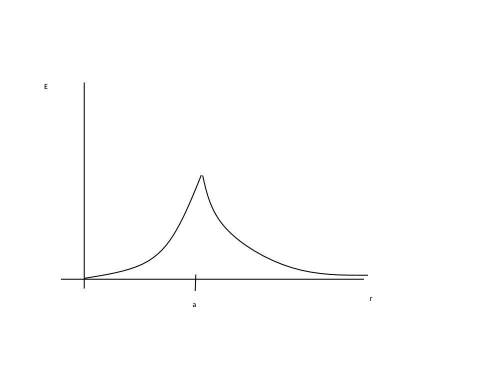
A positive charge distribution exists within a nonconducting spherical region of radius a. The volume charge density rho is not uniform but varies with the distance r from the center of the spherical charge distribution, according to the relationship rho = br for 0 < r < a, where b is a positive constant, and rho = 0, for r > a. a. In terms of B, a, and fundamental constants, determine the total charge Q in the spherical region.
b. In terms of B, r, a, and fundamental constants, determine the magnitude of the electric field at a point a distance r from the center of the spherical charge distribution for each of the following cases.
i. r > a
ii. r = a
iii. 0 < r < a
c. Quantitatively graph the electric field vs. r for 0 < r , 3a. Include labels and values on the axes.
d. In terms of B, a, and fundamental constants, determine the electric potential at a point a distance r from the center of the spherical charge distribution for each of the following cases:
i. r > a
ii. 0 < r < a

Answers: 3


Another question on Physics

Physics, 21.06.2019 18:00
Aproton is projected toward a fixed nucleus of charge +ze with velocity vo. initially the two particles are very far apart. when the proton is a distance r from the nucleus its velocity has decreased to 1/2vo. how far from the nucleus will the proton be when its velocity has dropped to 1/4vo?
Answers: 3

Physics, 21.06.2019 22:30
How have the competing explanations' experiments on atoms affected the development of the atomic model?
Answers: 1

Physics, 21.06.2019 23:30
Which lists the main components of darwin’s theory of evolution? a. random mutations drive evolution; the evolution of a population happens slowly; organisms have common ancestors; organisms do not change. b. natural selection drives evolution; the evolution of a population happens slowly; organisms have common ancestors; organisms change over time. c. natural selection drives evolution; the evolution of a population happens rapidly; organisms have common ancestors; organisms change over time. d. random mutations drive evolution; the evolution of a population happens rapidly; organisms have common ancestors; organisms do not change.
Answers: 1

Physics, 22.06.2019 06:30
Organelles are 1. responsible for producing power for the cell 2. tiny structures in the cell that carry out the cell's activities 3. responsible for digestion in the cell 4. found outside of the membrane
Answers: 1
You know the right answer?
A positive charge distribution exists within a nonconducting spherical region of radius a. The volum...
Questions





Mathematics, 21.10.2019 23:20



Mathematics, 21.10.2019 23:20

History, 21.10.2019 23:20

History, 21.10.2019 23:20

Mathematics, 21.10.2019 23:20

History, 21.10.2019 23:20


Chemistry, 21.10.2019 23:20



English, 21.10.2019 23:20



History, 21.10.2019 23:20




